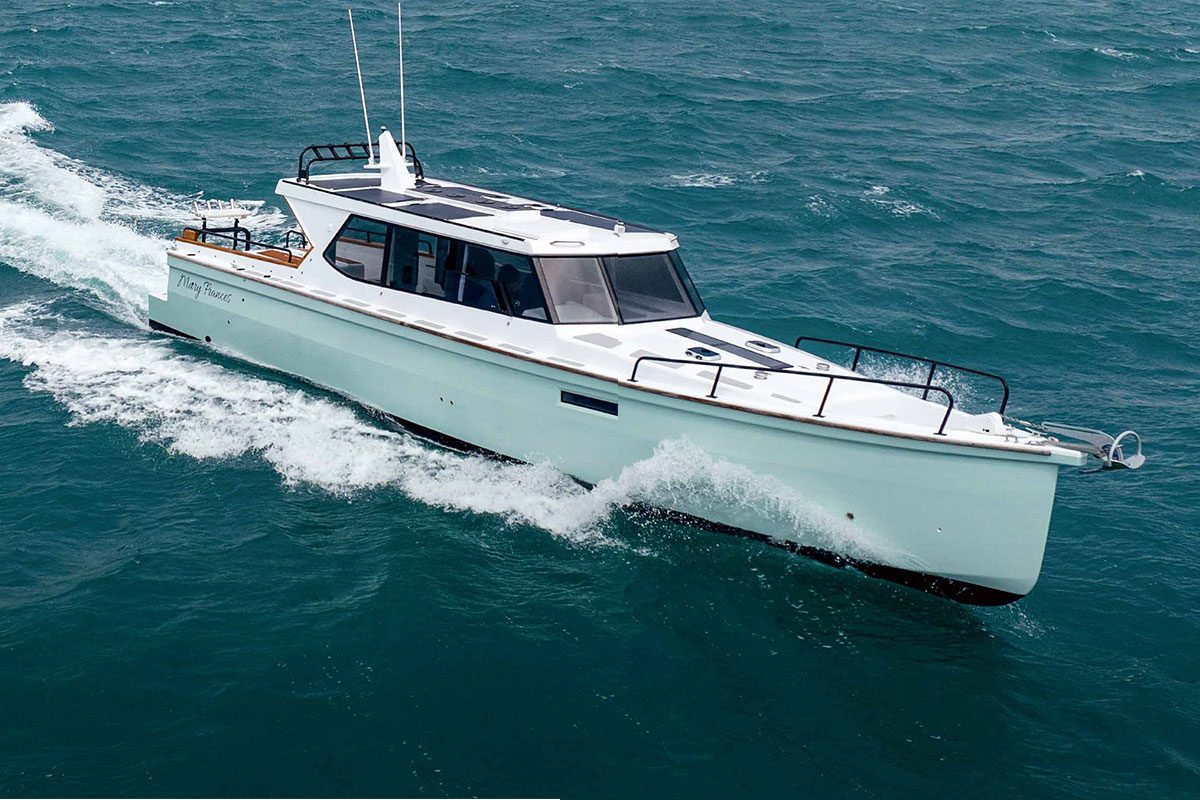

Six years ago Simon Justice sat in his classic timber launch, wondering whether she was worth the trouble. The elderly Ford engine had spewed oil from every orifice and seawater from the leaking stern gland sloshed through the bilges. Peeling paint, dodgy wiring and unreliable systems were crying out for work. A lot of work.
A depressed Justice considered his options. Something much better was required. Another secondhand boat didn’t appeal, and he decided he’d be better off building a new one. His needs were simple: a boat to go fishing and diving that could be handled alone, take two others if required, and most importantly, one that was fuel efficient and had an easy motion. And it shouldn’t cost more than $100,000.
He spent many months researching options through Google, eventually discovering American-based Mark Van Abbema’s design for an 11m hard chine, plywood commuter launch. This design was inspired by a 1920s-style Chesapeake Bay powerboat featuring a slender, easily-driven hull with a beam-to-length ratio of 4.5:1.

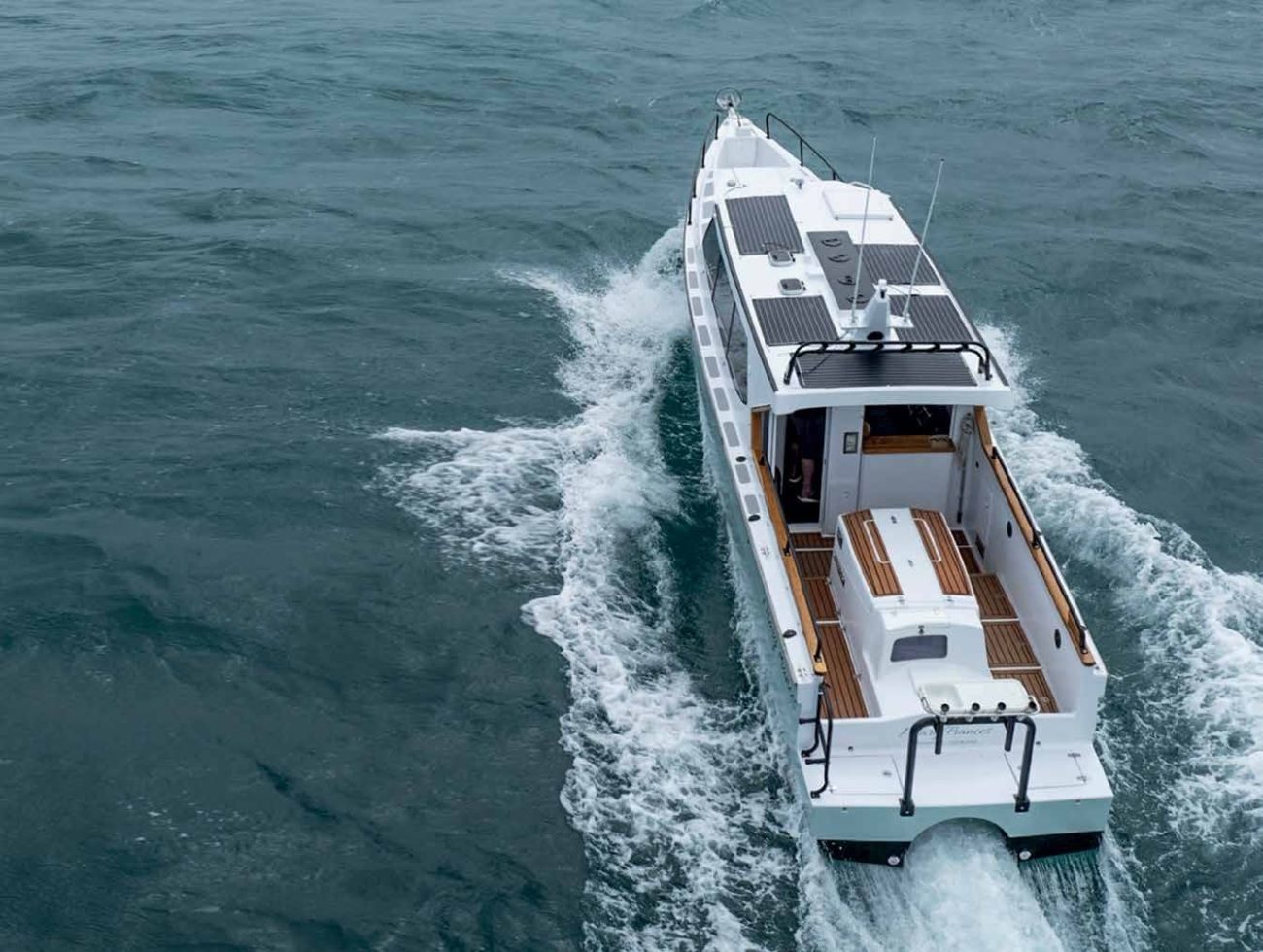
Justice bought the plans, which cost a princely $150, and built a model. This was smart as he could test a few modifications on the model before committing to the full-sized boat. He increased freeboard, length and headroom while modernising the cabin styling and windows.
With only a single garage he built the boat in three sections, split athwartships. The first section was the bow back to the steering bulkhead, and the second was the transom forward to the aft main cabin bulkhead. With these two sections completed, he set them out square, level and true, then built the centre main cabin section. While this sounds a trifle dodgy, there’s no trace of the joints either inside or out and, as the joints are well staggered, there is no loss of structural strength.
There are no frames per se, just the bulkheads, which are irregularly located to suit the accommodation. A mix of clean H3.2 treated pine clears, and kauri timbers were used for the keel, chines, stringers and gunwale. A stringer is located midway on the topsides, but none in the bottom sections. The hull bottom is two skins of Meranti plywood (6mm and 12mm), with a single skin of 12mm plywood for the topsides. An external box section gunwale increases deck width for better footing and adds considerable strength to the gunwale.
The complete hull was glassed with a layer of 780oz triaxial cloth set in epoxy at the rate of two litres per square metre and doubled at the chines and keel. “It was like trying to wet out a bathmat,” laughed Justice.

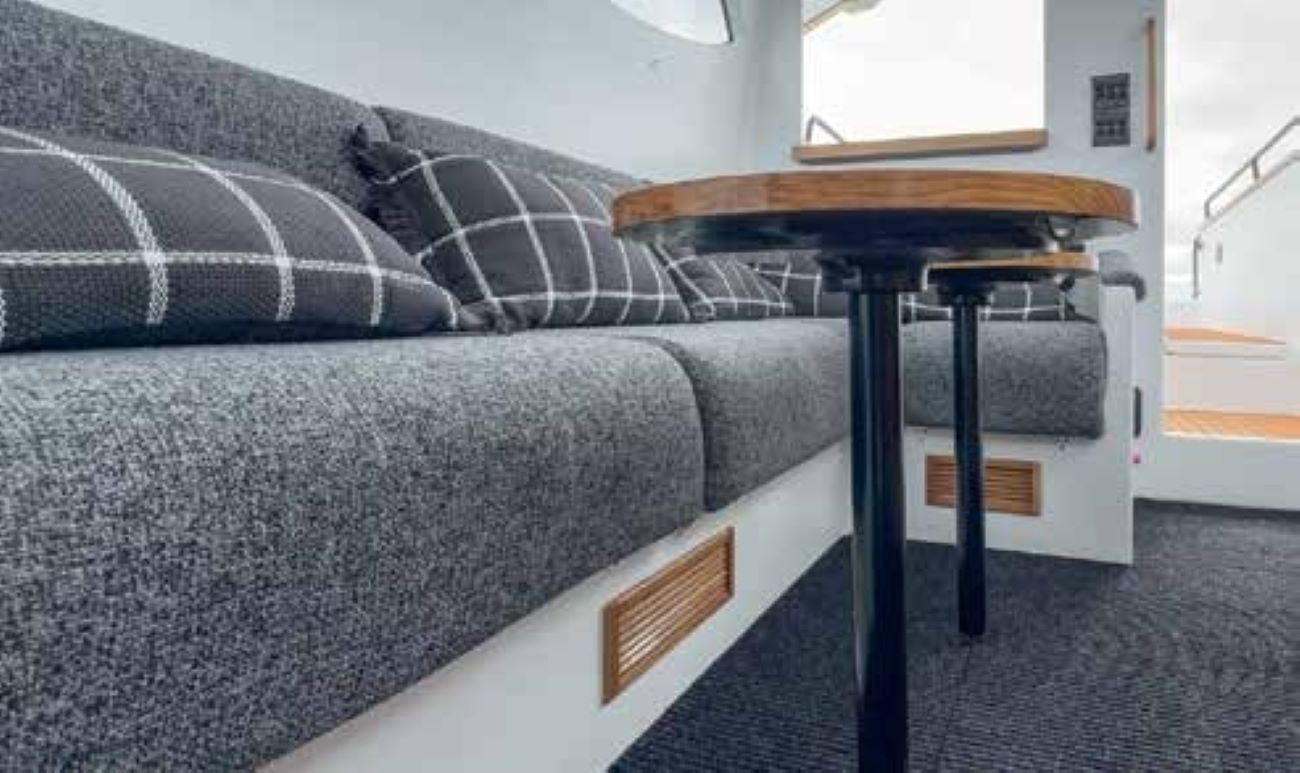
He added 1.8m to the stern to support a bigger engine, taking the overall length to 12.9m and the beam-to-length ratio to 4.7:1. However, the engine remains in the same position as designed. It’s in a tunnel, built in strip-planked plywood, glassed on both sides. A removable box covers the engine, with two removable panels – one for the powerhead, the other for the prop – for routine access.
The paint is all two-pack Hempel applied with a roller and brush, with what could be generously described as a 5m finish. In other words, it looks great from 5m away. But who cares? This is a working boat, and the price of getting a better finish would have been countless hours of longboarding and expensive spray painting.
With extensive business interests, Justice only worked on the boat nights and weekends over the six years, and apart from help from friends in turning the hull over, did everything else single-handed.
While Boat Haulage spent a whole day getting the boat up the drive of Justice’s Greenhithe property, the trip from there to Hobsonville Marina took mere minutes. This was six months ago and since then he has clocked up around 50 hours in the launch. He named her Mary Frances in honour of his late mother. Sadly, his father, John, died before launching and didn’t get to see the result.
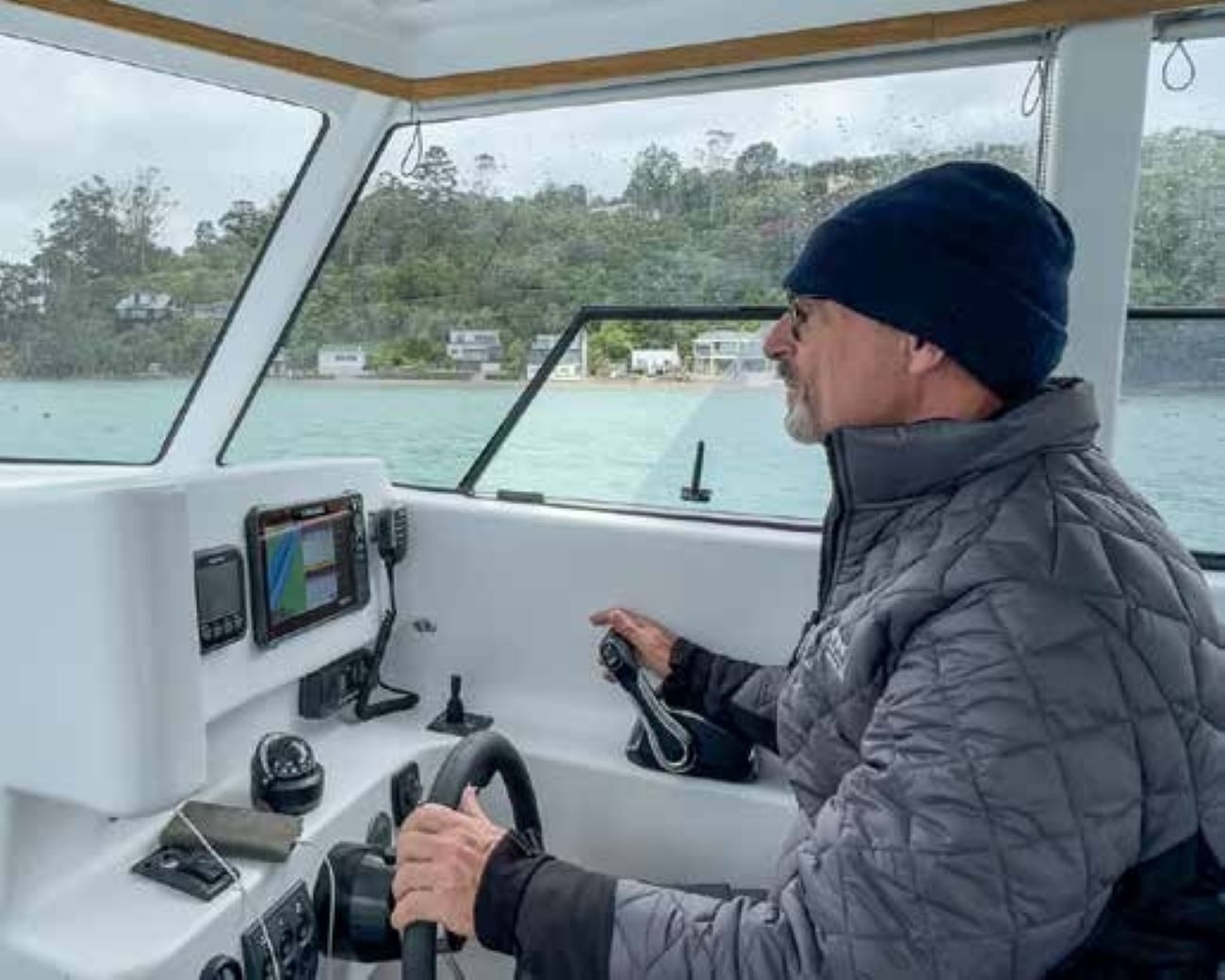
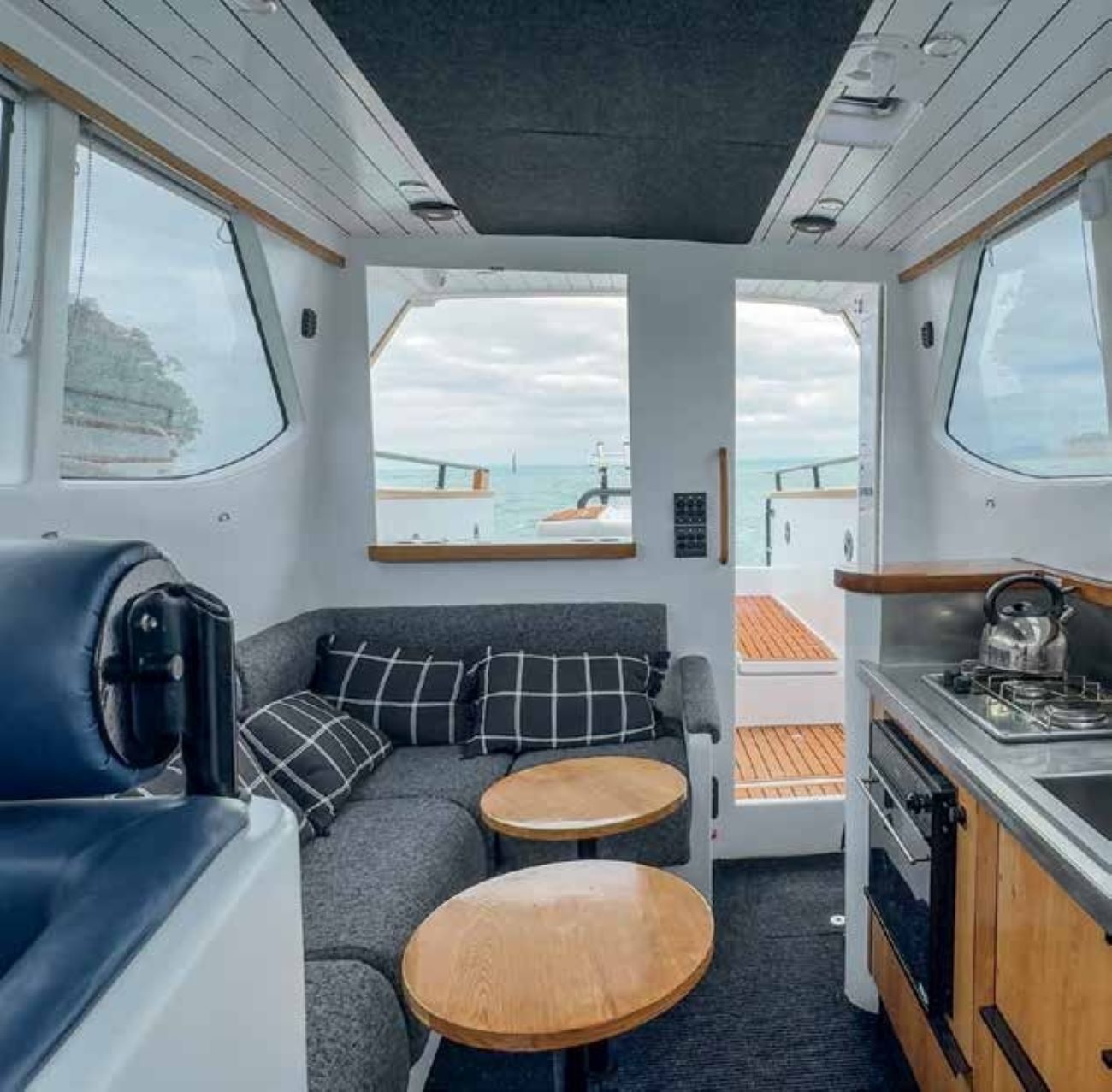
DOCKSIDE
Going aboard Mary Frances, a substantial engine box dominates the cockpit. However, there is still enough room aft and at the sides for fishing up to four people, while the step-through transom and wide boarding platform have been designed specifically for his passion for diving. There are lockers beneath the floor beside the engine box for fish tanks, LPG bottles and extra fuel.
The central cabin with a galley opposite is surprisingly spacious and lets one recline and see the side windows comfortably. The taller-than-average Justice built the main cabin with 2.2m headroom. Boating NZ’s tall photographer was very impressed.
The helmsperson has the best seat in the house, and the floor here is raised for comfort. A small compartment immediately forward of the helm houses the battery controls, switchboard and main batteries, which are located on a sliding shelf under the helm footrest. Opposite is a head compartment, with sitting headroom only. It’s a snug but workable space and even has a shower. There’s another shower in the cockpit – handy for divers.
Forward of this section, under the raised foredeck, is a two-berth cabin, with a hatch right forward to access the foredeck. This has an open cockpit, similar to some of the late John Spencer’s designs. Besides the solar panels, the cabin top front houses a 70-litre water tank, capped with a black aluminium panel. This warms the shower water, an excellent feature for divers. The black powder-coated aluminium handrails are a nice touch.
The 700-watt solar panels on the roof are channelled into a 240 AH house battery, and there are two other batteries, one for the engine and the other for the bow thruster. There are only three holes in the hull, one each for WC intake and outlet, plus a third for the saltwater wash down.
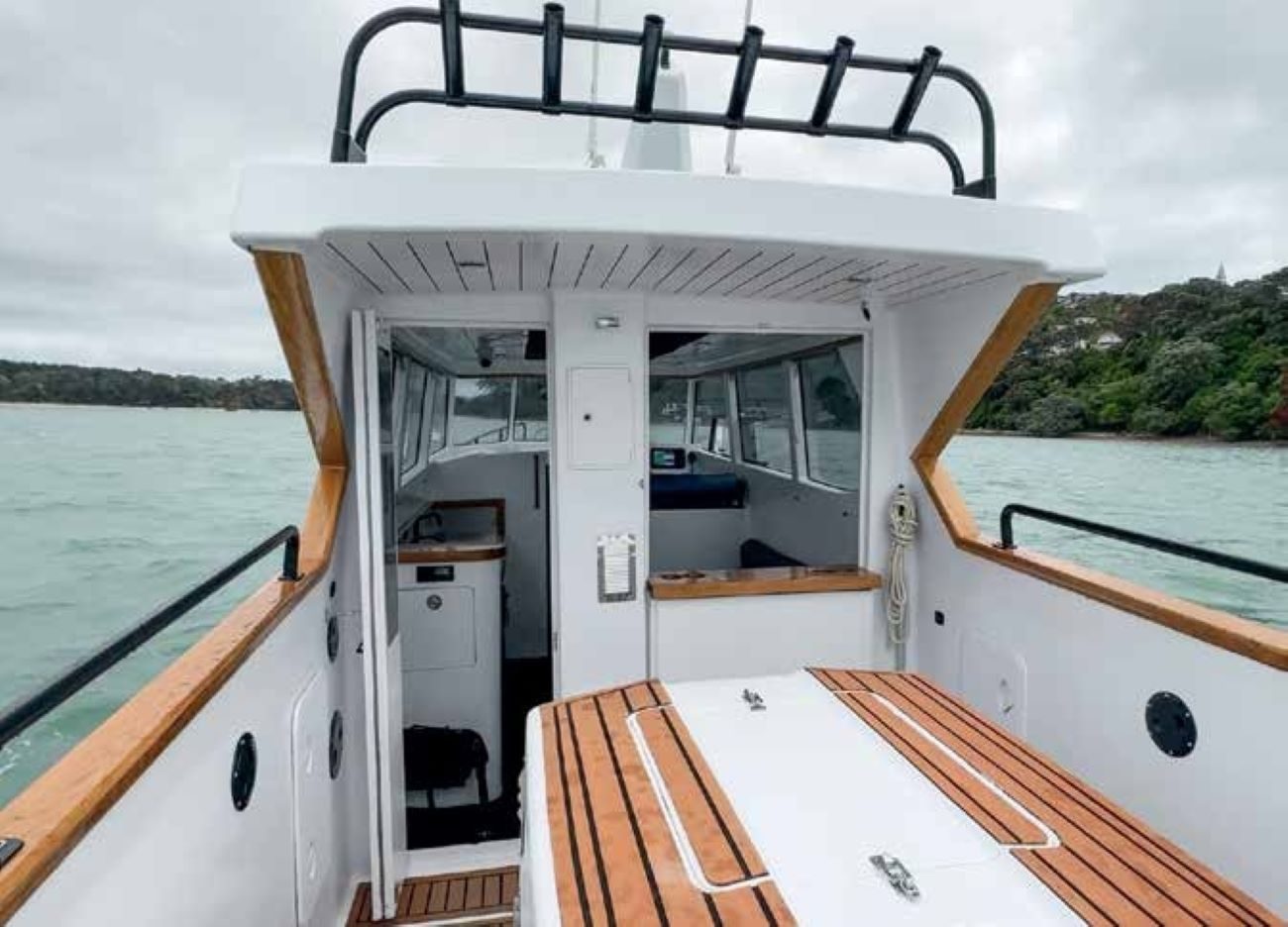
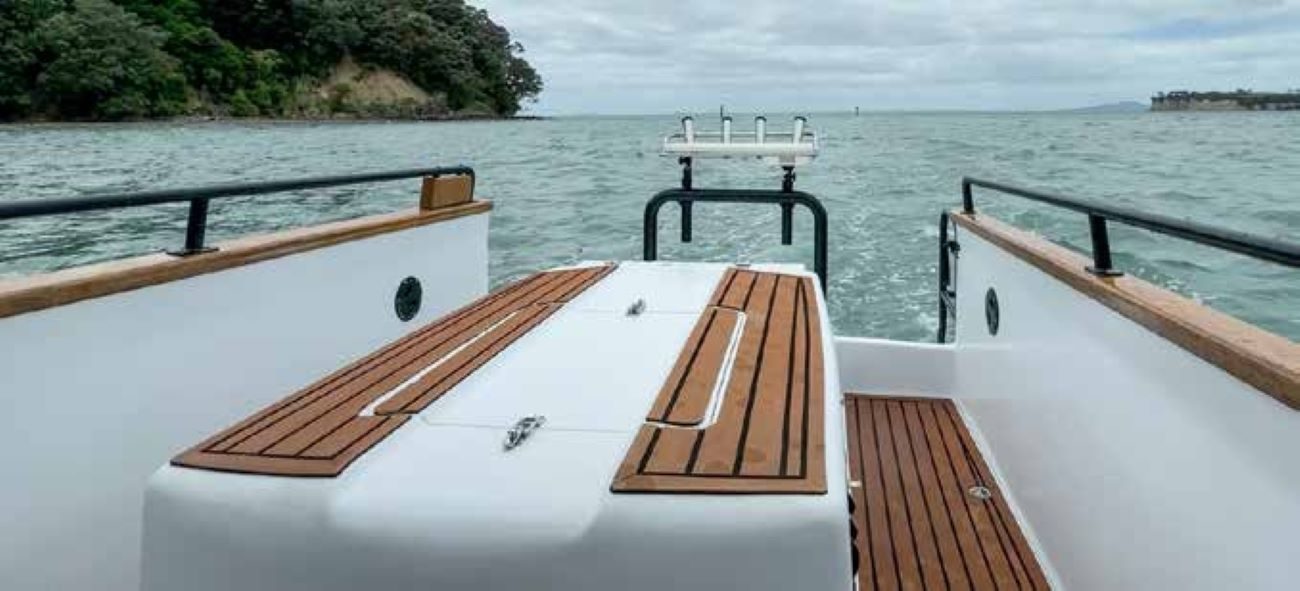
UNDERWAY
The test conditions were boisterous, with Coastguard Nowcasting reporting SW 25-knot gusting 35 at Tiri Island and 35 gusting 45 further out at Channel Island. Fortunately, the Weiti River provided a sheltered place to get underway.
Mary Frances was moored against the Weiti Boating Club wharf, bow onto an outgoing tide and the SW breeze. Getting off wasn’t difficult, but the need for a bow thruster was immediately apparent. Long, narrow boats much prefer to travel in a straight line, and we needed most of the distance between the wharf and the moored boats to make our turn. No big deal; one soon learns to adapt.
The Suzuki 140 is a four-stroke, four-cylinder with a 16-valve head. The two-litre unit develops 140hp at 5,700rpm. It’s torquey and very quiet under 3,000rpm. The engine’s 2.59:1 gearing allows it to swing a big propeller, well-suited to this hull type.
Considering Justice’s planned use, the outboard propulsion makes considerable sense. Because the engine can be raised entirely out of the water, growth and corrosion when moored are virtually non-existent, more so as he flushes the engine with fresh water after every use. Additionally, with the engine raised, the launch can float in 550mm of water, opening up a raft of potential anchorages denied to boats with inboard engines and under-hull rudders.
Travelling out to open water at 1,500rpm gave us 7.2 knots over the ground, with the engine burning around 10 litres per hour or 1.2 litres per nautical mile (lpnm). Once into open waters, we upped the engine to 5,000 rpm, which gave 15.8 knots, 38 litres per hour and 2.4 lpnm, respectively. Apart from the bow climbing a few degrees and the increased engine noise, the transition between displacement and planing speeds was seamless.
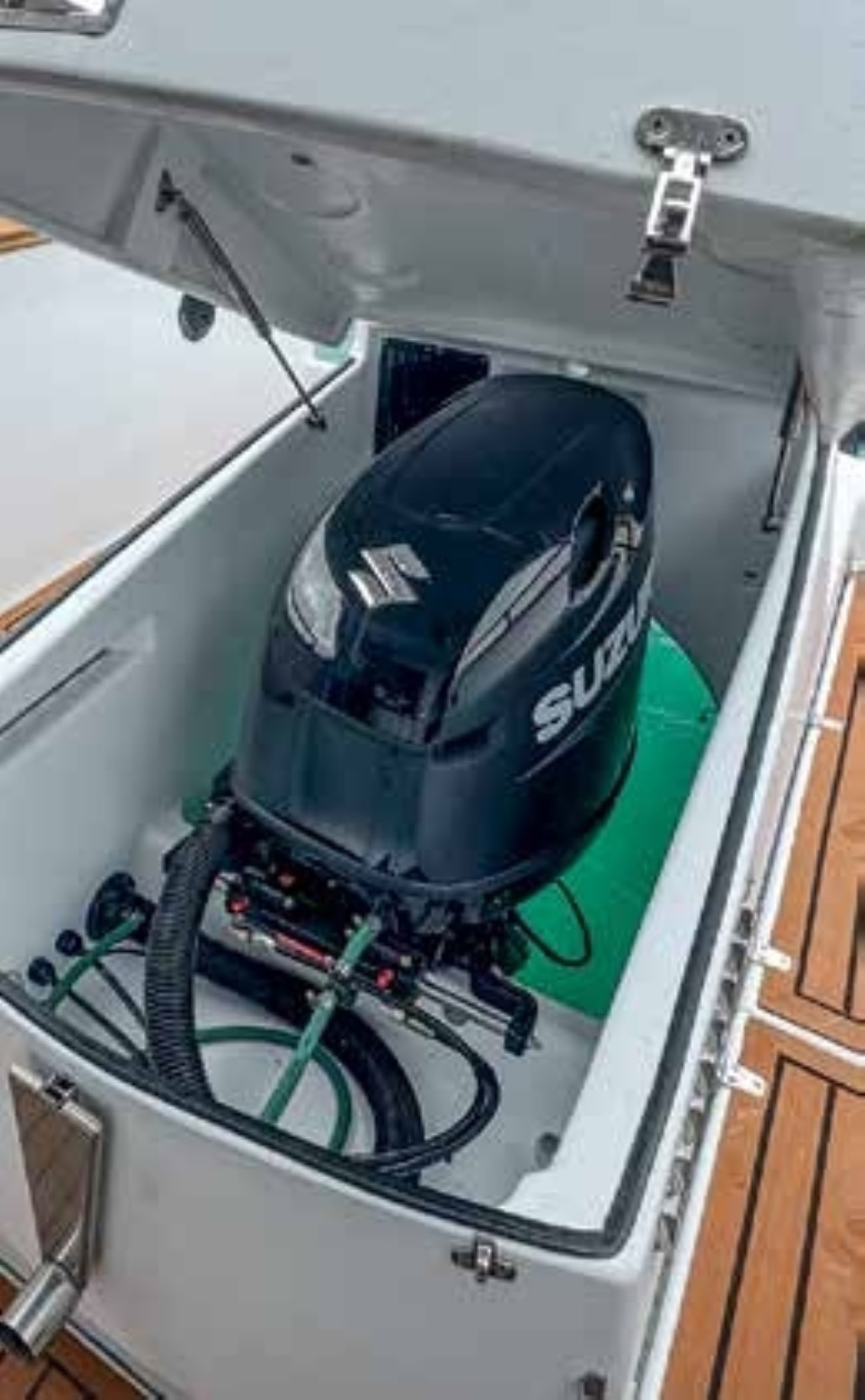
Shortly after launching, Justice and Bretts Marine tested five different propellers, the chosen one having the best balance between efficiency and speed. Changing propellers is a simple process compared to an inboard; with the engine raised, there’s a hatch directly above the propeller.
We began our test with a romp downwind at 14 knots, with Mary Frances sitting on the aft part of her hull and her bow out of the water. Provided the power is kept on, the long, narrow hull tracked well without the suspicion of a broach. The hydraulic steering was well-weighted, and the boat felt very controllable.
Turning around and bunting back upwind into the 25-knot breeze at 14 knots felt equally surefooted, but thanks to the vertical topsides, there was now a solid stream of water fire-hosing back over the cabin. Buttoning back to suit the conditions to a more realistic speed of eight to nine knots was drier, more comfortable and seamanlike.
This mightn’t seem particularly fast to people used to deep V powerboats, but nine knots dead to windward into a 25-knot breeze is more than attractive to a yachtie. Top marks to the builder, Mary Frances felt solid punching into the breeze, with no creaking, groaning or thumping.
Unquestionably, Mary Frances feels at her best going straight upwind or downwind. Beam onto the half-metre chop, she had a short, sharp roll, an inevitable function of her narrow beam. However, there was none of that ponderous, rhythmic rolling that some round bilge displacement boats can exhibit.
Importantly, on such a narrow hull, Justice wisely kept the water, fuel, and batteries low in the boat, which aids ultimate stability. Standing in the cabin, one’s feet are virtually at water level, which helps make the boat feel more secure.
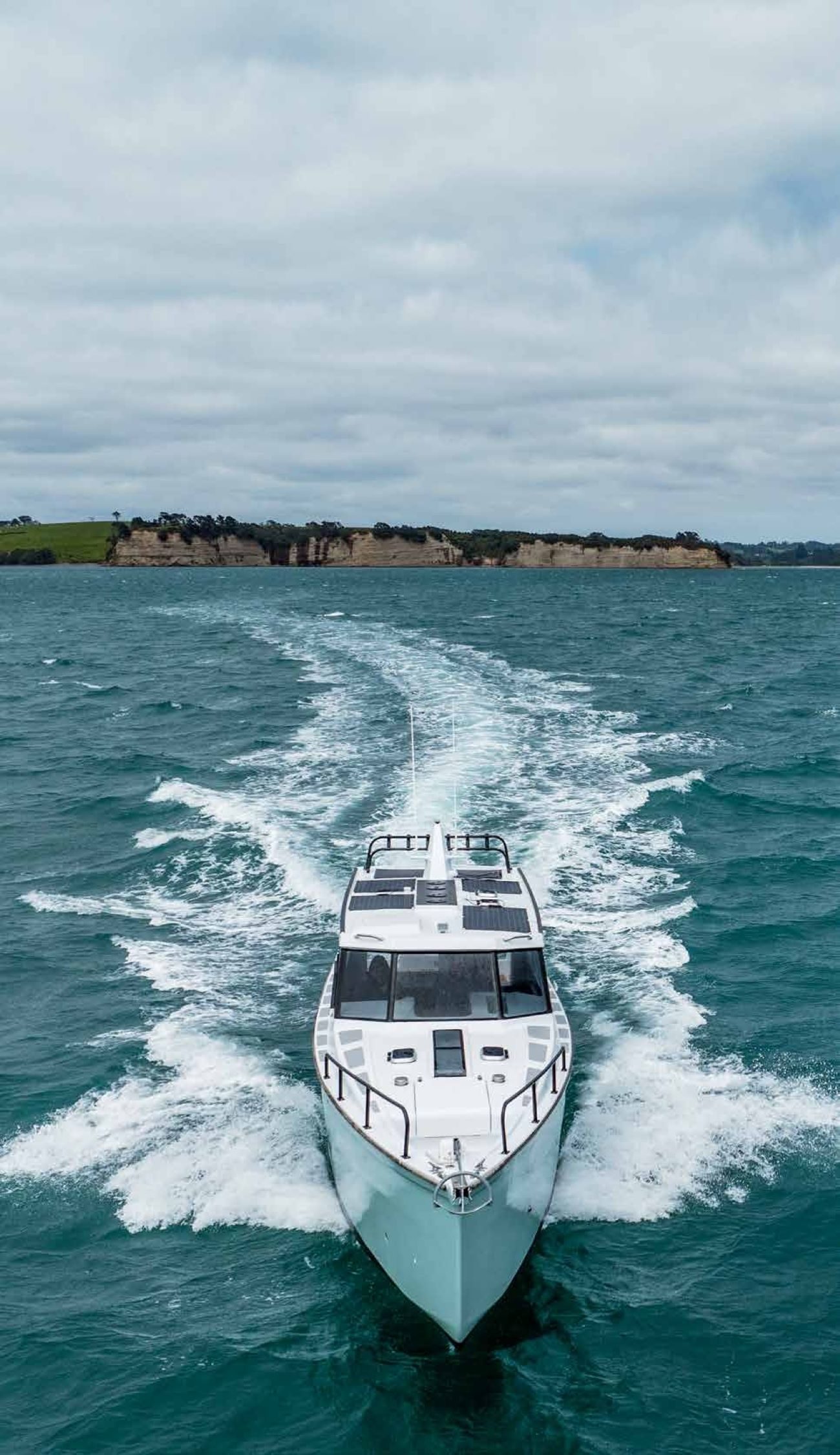
SUMMARY
Unquestionably, Mary Frances is the antithesis of most new GRP production boats. However, it’s based on a proven, time-honoured concept going back over 100 years, which is equally valid today. Long, narrow powerboats gain performance through low resistance and generally offer better fuel efficiency.
Unfortunately, the widespread introduction of marinas worldwide over the past 50 years has driven powerboat design in the opposite direction. At some point, the cost and availability of fossil fuels might force a rethink of this approach.
From a more local perspective, Mary Frances is living proof that an amateur builder, working by himself in a 6m garage, sticking to proven concepts and with careful thought, can create a professional, well-sorted boat that does precisely what it’s supposed to do.
Mary Frances – such a cool boat; Simon Justice, you should feel very proud. BNZ
Justice 13m
PRICE AS TESTED
Around $100,000 (materials only)
BUILT BY
The owner
KEY SUPPLIERS
Wairau Paints, Burnsco Westgate, Adhesive Technology, Brett’s Marine
HIGHLIGHTS
Slim, easily-driven hull with excellent fuel economy
Refreshing focus on form and function
Excellent boat for two, easy maintenance, shoal draft
SPECIFICATIONS
loa 12.9m
lwl 12.5m
beam 2.7m
draft (hull only) 550mm
displacement 2,950kg (dry)
engine Suzuki 140hp outboard
water 260 litres
fuel 320 litres main tanks,plus 100 litres reserve
range 300 nm (at 90% capacity and 8.5 knots)




